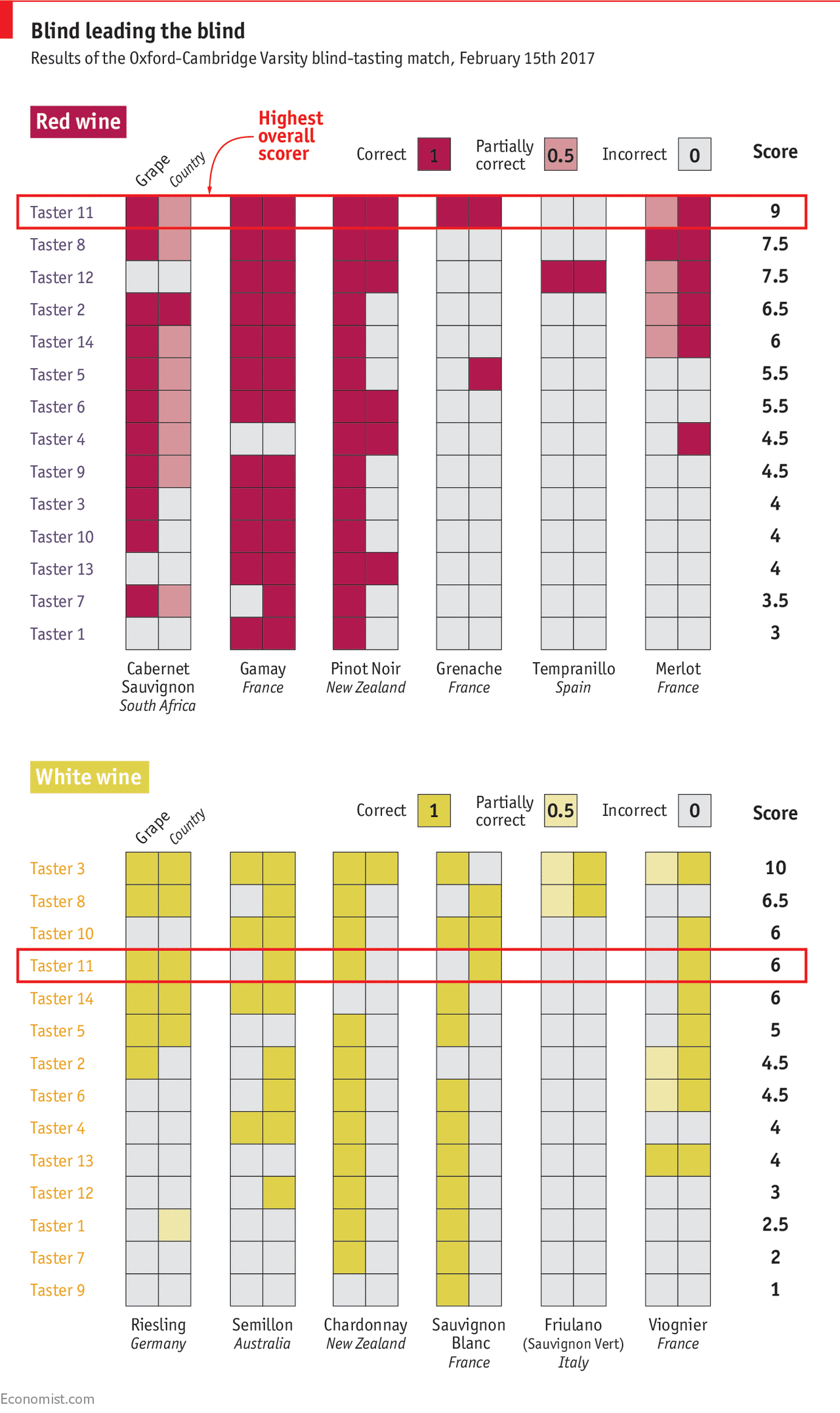Drinkers at the 2017 Oxford-Cambridge wine-tasting contest performed far better than random chance would indicate

“WINE tasting is bullshit”, proclaimed Robbie Gonzalez of the i09 blog a few years ago. Citing a series of academic studies, he argued—in rather more colourful language than their authors’—that there was no substance to the assessments of a wine′s quality made by wine “experts”, or their overblown language. In an article published in the latest issue of 1843, our sister magazine of ideas, lifestyle and culture, our data editor set out to disprove this widely held view. He attended an annual blind-tasting competition between students from Oxford and Cambridge universities, and found that the participants performed impressively well at identifying grape varieties and countries of origin using only their senses of sight, taste and smell.
For sceptical readers interested in taking a bigger swig of data, the main results of the 2017 Varsity blind-tasting match, held on February 15th, are depicted above. Two teams of seven tasters each (including one reserve per side) were presented with 12 wines, six whites and six reds. The judges granted each taster between zero and 20 points per wine, depending on how close (in their estimation) the drinkers’ guesses were to the correct answers, and how convincingly they explained their reasoning. However, we prefer a simpler scoring system: one point for getting the country of origin right, another point for getting the grape variety right and a judicious half-point of partial credit only in a handful of specific cases.
The group’s overall accuracy was far superior to what could be expected from random chance. Given the thousands of potential country-variety pairs, a monkey throwing darts would have virtually no hope of getting a single one right. But 47% of the Oxbridge tasters′ guesses on grape variety were correct, as were 37% on country of origin.
The competitors′ performances on each individual glass rarely matched these headline averages. Some wines were well-nigh unmistakable: all 14 drinkers identified the Pinot Noir, 12 called the Chardonnay and Gamay right and 11 identified the Sauvignon Blanc and Cabernet Sauvignon. Similarly, 13 participants recognised that the Gamay was from France (it is scarcely grown anywhere else), and nine said that the Semillon was Australian (though only four also determined that it was a Semillon). At the other extreme, no one knew what the Friulano was made from—an unsurprising result, since the grape is little-known internationally. Only one drinker nailed the Rioja (made from Tempranillo) and Châteauneuf-du-Pape (a Grenache-based blend), wines from prominent regions that should have been relatively easy to spot.
Similarly, the averages obscured wide differences in performance among individual drinkers. Taster number 11—the sheets are anonymous—got 8.5 of his or her 12 country guesses right (with a half-point for placing a South African Cabernet Sauvignon in Chile), whereas taster number 1 got every country wrong save for putting the Beaujolais (made from Gamay) in France. The variety guesses were clustered together more closely, with a low of four correct answers (for tasters 1, 7 and 9) and a high of eight (for taster number 3, counting two half-points). However, based on data from a single trial, it is hard to tell whether these gaps primarily reflect true differences in skill between drinkers or mere random variation.
For readers interested in learning more about the blind-tasting contest, Pol Roger, its sponsor, has published a history by Jennifer Segal called “Reds, Whites and Varsity Blues”. It is available here.
We granted half-points for the following guesses:
1. For the German Riesling, placing it in neighbouring Alsace, France—so long as the variety was correctly listed as Riesling
2. For the obscure northern Italian Friulano grape, listing any other northern Italian variety
3. For the often-blended white Rhône variety Viognier, listing any other white Rhône variety
4. For the South African Cabernet Sauvignon, choosing any other New World country of origin—so long as the variety was correctly listed as Cabernet Sauvignon
5. For the Merlot-based Bordeaux, listing Cabernet Sauvignon (the other leading Bordeaux variety)—so long as the region was correctly listed as Bordeaux
www.economist.com
No hay comentarios.:
Publicar un comentario